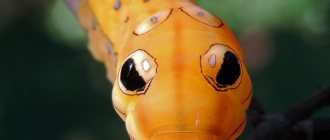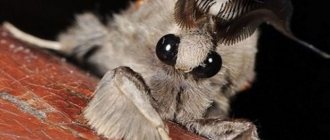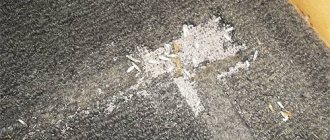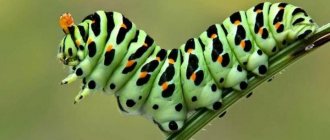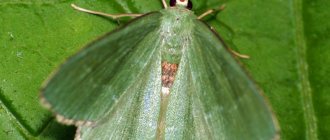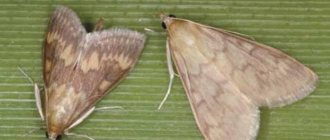Before a new butterfly appears, it undergoes a certain cycle of metamorphosis with a larva and a caterpillar. This is simply an incredible transformation mechanism developed by nature itself. For a caterpillar to turn into a butterfly, it is digested using enzymes produced by hormones. Then the sleeping cells (similar to stem cells) turn into body parts of the future insect.
Stages of development
Before a butterfly appears, it goes through 4 stages of development.
The process may take several months:
- Stage 1. In the first stage, the female butterfly lays eggs, so at first the butterfly is a larva. The eggs are laid very close to each other on the leaf. After about 5 days, the larvae become small and round. Tiny worm-like creatures then hatch into the light.
- Stage 2. In the second stage, the caterpillar has a long body and looks like a worm. The newly hatched insect is very hungry, so it immediately starts devouring leaves and flowers. The leaf where the creature hatched is eaten first. At this stage, active growth occurs, because a lot of food is consumed. The caterpillar grows so quickly that it becomes too large for its shell, so the old cover must be removed. Then a new one appears. During the growth period, the shell is shed 4 or more times. This process is called molting. The stage does not last long, and all the caterpillar does during this time is eat.
- Stage 3. At the third stage of development, the pupa appears. Its color is brown or green - the color of the environment, thus making the pupa invisible, which protects it from predators. This is the resting stage. The caterpillar begins to change - turn into a butterfly. Her appearance is transformed, her form changes. Change is happening quickly. Next comes the transformation into a butterfly. All metamorphoses occur inside the pupa. The process does not take much time.
- Stage 4: In the fourth stage, the pupa opens and soon the butterfly emerges, sometimes called the adult. Butterflies are very bright. At hatching, the soft wings are moist and wrap around the body. Since the process of emerging from the pupa is tedious, after birth the butterfly lies for some time. It will begin to pump blood into the wings, which should make them work (flap). Butterflies cannot fly well right away; they need practice, which does not take much time. They learn quickly. When she can fly, she will go looking for food and a companion, find him and lay eggs. The life cycle will repeat.
Why does a caterpillar turn into a butterfly?
Before turning into a butterfly, the caterpillar must go through several stages of metamorphosis. The paradox is that this process has not changed at all since the Jurassic period. It looks like this:
The butterfly lays eggs, from which, two weeks later, caterpillars hatch. Their main goal is to accumulate a sufficient amount of energy during their existence. This is the reason for their huge appetite. Growing up, the caterpillar molts several times, usually from four to sixteen times. It all depends on the type of insect and its lifestyle.
As a rule, the development of caterpillars occurs on plant leaves, under the bark of trees, as well as in cereals and grains. It all depends on what they eat and what lifestyle they lead.
The butterfly becomes capable of reproduction in the imago stage. Its duration depends on the type of insect, and can range from one to twenty days. While in this stage, the insect may not consume food at all. Only some of their species feed on flower nectar and berry juices. Those insects that live in northern latitudes go through a longer stage of metamorphosis. Having transformed into a pupa, the larva remains in this form to overwinter until spring. At the same time, it is able to withstand extremely low ambient temperatures, down to minus seventy degrees. There are also species of butterflies whose metamorphosis process takes up to fourteen years. In any case, at the final stage the larva pupates, attaches itself to the leaves or branches of a tree, and freezes to turn into an adult insect - a butterfly.
How long will this process take? Everything here, again, depends on the type of insect and the climatic conditions in which it is located. For most species of butterflies, this process takes from one day to a week, but there are also species that turn into an adult insect within 14 years.
It turns out that the reason for the transformation of a caterpillar into a butterfly is caused by an evolutionary process associated with the degeneration of forms. In our case, the caterpillar turns into a butterfly. This is quite an interesting process. The body of the caterpillar turns into a liquid state, with the simultaneous formation of imaginal discs. To put it simply, this process is associated with the creation of a cluster of stem cells, from which insect organs will subsequently be formed. After this process is completed, the insect in the cocoon begins to secrete a fission secretion. Under its influence, the cocoon shell bursts and the butterfly comes out. She spreads her wings, dries them, and then takes off.
Her task is to find an individual of the opposite sex, mate, lay eggs, and die. After this, the whole process is repeated again. If the caterpillar manages to turn into a pupa, then it will definitely transform into a butterfly. However, the process of metamorphosis is characteristic not only of moths, but also of beetles. Their larvae also look like caterpillars, although they are called false caterpillars.
What happens during metamorphosis
Juvenile hormone delays metamorphosis at the larval stage. It works by blocking genes in imaginary discs—tiny disc-shaped sacs that are triggered when the caterpillar wraps itself into a chrysalis and turn into the butterfly's antenna, eye, wing or other element. Thus, the hormone is necessary for survival until metamorphosis.
As soon as the larva undergoes its final molt and metamorphosis begins, strange things happen to its body. Cells in the muscles, intestines and salivary glands are digested and serve as “spare parts” for the future butterfly. Every cell is programmed to destroy itself through the activation of enzymes called caspases.
Caspases are ruptured by a protein in cells, releasing the basic material to create butterflies. If not for the juvenile hormone, this could have happened at any time, killing the insect. Instead, nature programmed it to lower its level at the ideal moment for metamorphosis.
With less juvenile hormone, pupation occurs instead of regular molting.
Once the caterpillar has expanded all its tissues except the imaginal discs, they use the protein-rich broth that surrounds them to stimulate the rapid cell division necessary to form the wings, antennae, legs, eyes, genitals and other elements found in an adult butterfly or moth. For example, an imaginary fruit fly wing disk may initially consist of 50 cells and increase to more than 50,000 cells by the end of metamorphosis.
Metamorphosis is more than just a stunning physical transformation. This is a clear demonstration of the evolutionary mechanism. Butterflies and caterpillars not only differ strikingly in appearance, but also behave differently. The caterpillar lives on a tree, and the butterfly flutters. The first eats leaves, and the second feeds exclusively on nectar.
There are many opportunities for coexistence in an ecosystem as long as they do not encroach on each other's food supplies.
The mystery of how a caterpillar turns into a butterfly is no longer a secret.
Butterflies are wonderful and beautiful creatures that delight us every summer day.
Everyone knows that butterflies emerge from caterpillars, but how this happens will definitely surprise you, but let’s leave a little intrigue.
During its short life, the caterpillar rapidly gains weight, eating everything it likes from the local flora - leaves, grass, some butterfly caterpillars eat only certain plants.
The caterpillar can eventually grow to a very large size, depending on the species.
Caterpillar, future butterfly
And, of course, everyone knows that at some point the caterpillar pupates - it attaches itself somewhere and turns into a cocoon.
The result is a butterfly - in a week, two or a month
Cocoon
But how does it happen that a caterpillar turns into such a completely different insect in all forms?
The answer here will be both shocking and interesting in its natural design.
And what happens there is nothing more than dissolution
caterpillars into a kind of nutrient broth.
As soon as the cocoon appears, the caterpillar secretes enzymes that almost completely digest the insect
into protein liquid - which is why it is so important for the caterpillar
to quickly gain weight and obtain as much building material as possible for the future butterfly
. However, special “memory cells” are preserved in this liquid, on the basis of which all the necessary organs of the butterfly then grow from this substrate.
From cocoon to butterfly
These cells contain a genetic code that essentially launches a new process of creating a living creature - wings, eyes, paws, a proboscis are quickly formed - completely different from the original caterpillar. The insect is “constructed” anew.
Sometimes caterpillars look nothing like butterflies, and sometimes memory cells form vestigial organs even before the pupation stage, but the main changes occur in the cocoon.
After such information, butterflies on flowers are perceived in a slightly new way, and the process of transition from a caterpillar to a beautiful butterfly now looks completely fantastic, because we usually do not think at all about the processes that occur inside the cocoon, but are content only with classical schemes, when the caterpillar suddenly becomes winged beauty.
Interesting comments:
-Conclusion: those born to crawl can fly!
— I would like to add from the article: for this you need to boil in broth and grow new organs)))
- like in the fairy tale about the little humpbacked horse: you are boiled in three cauldrons
Caterpillar food
Almost all caterpillars feed on leaves, but most are very picky. In fact, the insect will only eat one type of leaf, and perhaps only from one particular tree or plant.
If the insect on the plant is what she eats, you can start giving fresh leaves from that plant. Every 2 days you need to give clean, fresh leaves.
If the insect is not found on a plant - for example, on the ground or indoors - it is probably looking for a cozy place where it wants to turn into a pupa. This means the insect is full. It is better to give it a “salad” of leaves collected from trees and plants nearby, the caterpillar may eat them, but if this does not happen, then it is ready to shed its shell and begin to transform into an adult moth or butterfly.
Where do new butterflies come from?
After the butterfly is born from the pupa, a few hours later it looks for a partner. Some species sense their mate from a great distance. After their meeting and mating, the female lays eggs, this is just the first stage of formation, the butterfly has four of them in total.
- Egg.
- Larva.
- Doll.
- Butterfly.
Some butterflies lay up to 1000 eggs per summer. To prevent the eggs from being destroyed, the female hides them: in the soil, under leaves, in special capsules from her glands, under multi-colored scales, and even transfers them to ants for storage.
The last method is the most unusual, it is used by a certain species of butterfly - the blueberry. The ants hide their larvae for the winter in their anthill, and when the caterpillars appear, the ants give them their larvae to be eaten. Ants tolerate such proximity for a reason; they feed on a special liquid that the caterpillars secrete.
Butterfly larva
The larva emerges from the egg, the shell of which it eats as soon as it leaves it. After which the newborn caterpillar begins to eat the leaf. Most often, caterpillars live separately, but some remain a family until they transform into a pupa.
Caterpillar molt
During the process of growing, the caterpillar sheds its skin several times, much like our clothes when we grow out of it. At the same time, the skin from the head does not lose its shape, as if it had taken off a carnival mask, and the skin of the body is crumpled into an accordion.
Doll
When the caterpillar reaches the desired size, the pupation process begins. Outwardly, it looks as if it clung to a branch and froze; over time, the larva will turn into a pupa and will remain in this state until it becomes a butterfly. It is the pupa that freezes, and the larva itself reacts inside it to extraneous movements, but it should not be specifically disturbed.
It remains in the pupal state from a couple of weeks to several months. You cannot break the pupa, as this will prevent the butterfly from flying out earlier. In the cocoon she changes, her wings grow, and her skin changes. If you break its shell ahead of time, the butterfly will die. After the changes are completed, she will destroy the cocoon and climb out.
The first hours of a butterfly's life
Before it can fly, a butterfly must spread its wings. While in the pupa, they were pressed tightly to its body. As soon as they straighten out and dry completely, she will fly in search of her mate and also lay eggs. Giving life to new butterflies.
What do adult butterflies eat?
They no longer “gnaw” leaves, and not because butterflies are more sophisticated creatures than caterpillars, but because they lack a gnawing mouthpart. But they have a proboscis, with which they drink various liquids, almost like we do through a straw. They drink not only nectar, but also water from puddles, the juice of trees and fruits, and some even the blood of buffaloes.
How to raise an insect
It is possible to create an ideal living environment, but you need to consider a few important things:
- Take a clean food container.
- Fold the paper towel and place it at the bottom of the container.
- Place a regular dry stick or popsicle stick (or two) into the container.
- Carefully place the caterpillar into the container. If it is on a sheet, place the sheet with it.
- If the insect was on the plant and is still eating, store fresh leaves in a container until pupation.
- If the insect sways, it needs to be cleaned. You may need to replace the paper towel from time to time.
- If an insect crawls into a paper towel and disappears, it is probably hiding before pupating.
- Once it pupates, the butterfly will hatch.
The process of turning a larva into an adult butterfly takes a long time, and during most of this period nothing seems to happen. It's even difficult to tell whether the caterpillar is alive or not. The pupal stage can last weeks and often months—many species pupate throughout the winter and hatch the following summer.
There are about 400 species of butterflies and more than 10,000 species of moths. Moths tend to be more common. For every butterfly caterpillar found, there are usually 20 moth caterpillars.
Parasitic wasps and flies
If the caterpillar stops moving and suddenly develops a small white rash, this is bad. Very often, caterpillars are attacked by tiny wasps or flies. These parasites lay eggs, and then tiny wasps or fly larvae live by feeding on the insect's internal fat, but this does not kill the caterpillar.
Over time, these small wasp or fly larvae become larger and larger. When it's time to spin cocoons, small larvae leave the caterpillar's skin and make cocoons on the surface. The white rash is the cocoons of parasitic wasp larvae. Soon they will hatch, turn into small black wasps and fly away to repeat the process.
If the insect has become a stationary brown pupa, then all its cells turn into an adult butterfly or moth. If the insect is truly dead, it will dry out and turn into a slightly shriveled "raisin" then it's time to say goodbye. But usually it’s just rest and metamorphosis.


